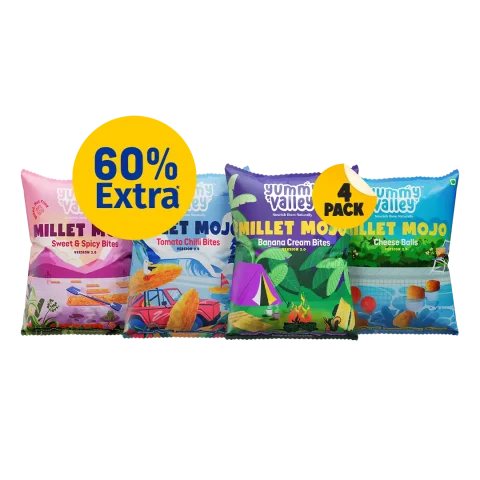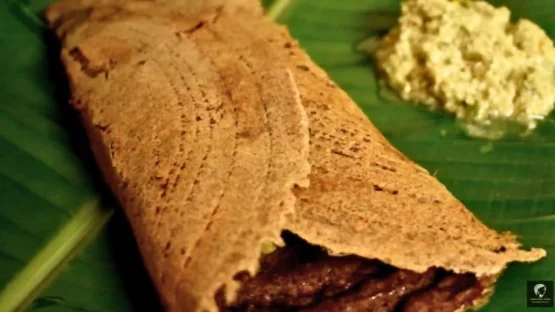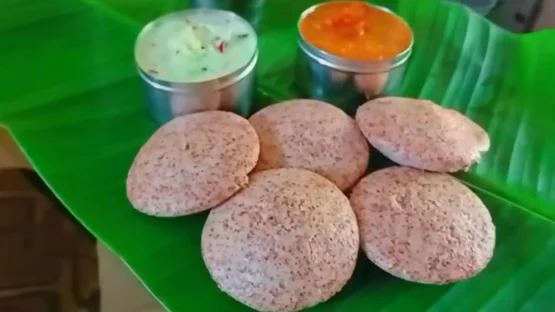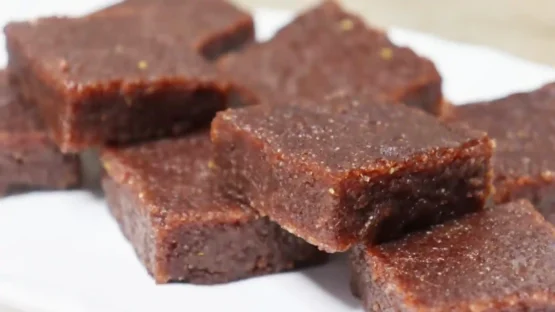YUMMY VALLEY’S SALE 🎁
Upto 20% Off
Get 1 Free Millet Bite Pack With Every Order
- Your cart is empty
- Continue Shopping
Ragi Benefits & Side Effects: The Ultimate Guide
- Published on:
- Last update: 09 July 2024
- Post updated 6 times
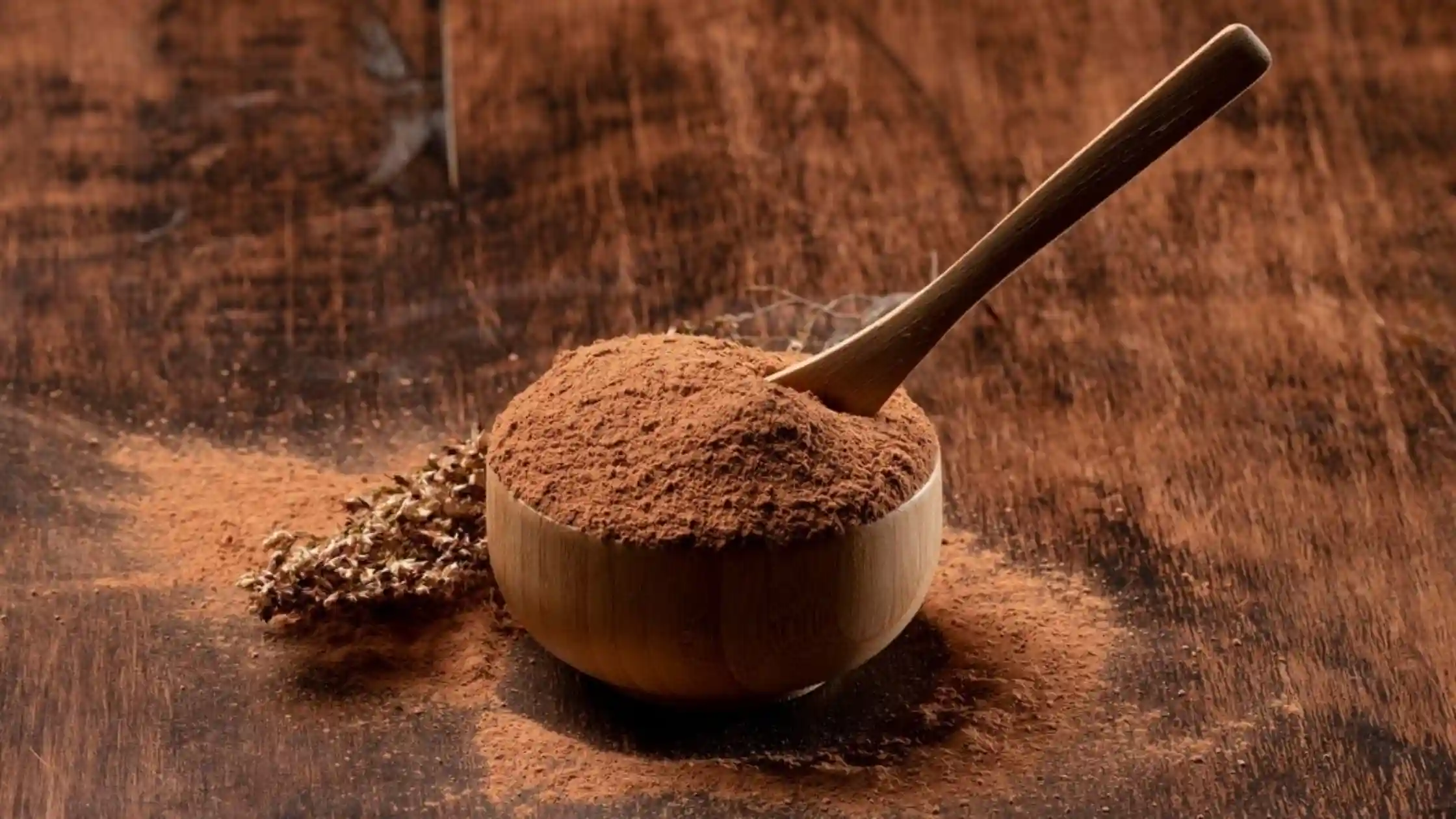
Ragi also called Finger millet is the most widely consumed grain in parts of South India and several parts of Africa. It contains high dietary fibre and calcium and for this reason makes it considered a super grain for those tried to lose some weight. Moreover, ragi is highly advantageous for individuals with diabetes and is a fundamental component of South Indian baby food, as it supports digestion and promotes bone development in infants due to its significant calcium and iron levels.
Table of Contents
ToggleWhat Is Ragi?
Ragi which is also known as nachani is a very rich grain that contains protein iron and calcium. It is mainly cultivated in India where it leads in production globally. Of these, ragi is esp rich in certain amino acids such as phenylalanine, methionine, isoleucine and leucine. In addition, the resistance to environmental stresses particularly in the case of drought makes it be among the best crops to cultivate.
Ragi Nutritional Value (per 100g)
Ragi includes lots of Macro vitamins together with carbohydrates, fibers, fats and protein and plenty of micro nutrient contents consisting of vitamins and mineral. Little or no cholesterol or sodium content makes it a friendly food for the heart and the immune boosting vitamins C & E for skin and hair Among the impressive list of nutrients, it contains all the B-complex vitamins, calcium, magnesium, iron, phosphorus, and thus the preferred choice for a healthy breakfast cereal and for a ‘Super food’.
Nutritional values for 100 grams of ragi flour are as follows:
| Nutrient | Amount |
|---|---|
| Energy | 328 Kcal |
| Protein | 7.30 gm. |
| Carbohydrates | 72 gm. |
| Fat | 1.30 gm. |
| Dietary fibre | 11.50 gm. |
| Iron | 3.9 mg. |
| Sodium | 11 mg. |
| Calcium | 344 mg. |
| Potassium | 408 mg. |
| Carotene | 42 μg. |
Ragi is an Indian staple meals that is rich in fibre and may be used as an alternative to different cereal and grain crops. It is a wealthy supply of critical amino acids which might be hardly located in vegetation; therefore, it’s useful for vegetarians and vegans.
you save ₹42
Health Benefits Of Ragi
Traditionally, ragi, brown rice, and barley were part of the Indian diets were part of the ancient Indian diets. However, these whole grains were replaced by convenient instant foods that had greater access during the internet age and hence the poor health risks. To combat these risks, doctors now advise both diabetic patients and healthy individuals to incorporate ragi into their diets for its numerous long-term benefits. However, the consumption of ragi has noticeably decreased among teenagers. Let’s explore the top advantages and benefits that ragi provides.
1. High Protein
A high protein source for vegetarians, ragi contains 5% methionine and helps prevent malnutrition. A small grain size makes it easy to consume in its purest form.
2. Natural weight loss agent
Including ragi in the diet is beneficial as it has high fiber content; those who consume ragi will not feel hungry often; thus, managing their food portions to lose weight. It is an appetite suppressant that has Tryptophan which is an amino acid naturally.
3. Prevents skin ageing
Methionine, and Lysine present in Ragi assist in preventing skin ageing, renewal of skin cells to make it look young.
4. Good for hair
Ragi is loaded with proteins and people have claimed to boost hair glamour, check hair loss, and early greying. It helps in hair growth as well as circulation.
5. Rich in calcium
Ragi is also high in calcium, this is beneficial in strengthening the bones and might help in the prevention of osteoporosis. A hundred grams serving contains 344 milligrams of calcium.
6. Increases mothers’ milk production
An important source of essential amino acids, calcium, and iron, green ragi boosts haemoglobin levels and milk production in lactating women.
7. Prevents diabetes
It lowers blood sugar levels and stabilises them, reducing the risk of diabetes, thanks to the polyphenols and dietary fibres in ragi.
8. Aids digestion
Ragi’s dietary fibre boosts digestion, smoothens intestinal flow, and aids in waste excretion, improving overall health.
9. Keeps you relaxed
As a natural relaxant, ragi relieves anxiety, insomnia, and depression, allowing you to feel calm and relaxed.
10. Prevents colon cancer
Ragi contains fibre and phytonutrients that reduce colon cancer risks. The lignan in ragi is converted to mammalian lignan, which prevents breast cancer.
Benefits Of Ragi For Babies
Parents especially those who have new babies should be informed that ragi has properties that are good for their babies. Ragi should be incorporated into a baby food menu as from the age of six months since it is a nutritional booster. The following are a number of the advantages of ragi for babies:
1. Rich calcium source
Calcium is important in the building of new bones and also for avoiding breakages of bones in the body.
2. Aids digestion and satiation
It is also good to incorporate fibre in the babies’ diet as it enhances digestion and ensures that the baby is full between feeds while Amino acids reduce the levels of fat and cholesterol hence preventing obesity.
3. Natural iron
Iron and Vitamin C in sprouted ragi limit anaemia and prevent malnutrition by enhancing iron absorption.
4. Natural relaxant
Having antioxidants prevents insomnia, tension, and complications.
5. Improves skin and hair
It is assumed that methionine promotes healthy skin and hair.
6. Boosts immunity
Infants need to devour vitamins and minerals that fortify their immune structures to fight infections.
7. Supports healthful weight gain
Healthy weight advantage and boom milestones are supported through balanced vitamins and excessive fibre.
8. Enhances brain development
In addition to assisting cognitive characteristic and neurological health, amino acids and vitamins support mind development.
you save ₹19
Ragi Recipes to Try
If you are new to ragi, you may find it difficult when you taste it for the first time. If you learn to like its taste, you’ll stay healthy as you age.
1. Ragi Onion Masala Dosa
Adding ragi flour to your masala dosa batter will make it healthier. Make your breakfast nutritious by serving it with potato curry.
Ingredients
- 1 cup ragi flour
- ¼ cup rice flour
- ¼ cup yogurt
- 1 chopped onion
- 1 chopped green chilli
- 1 tablespoon coriander leaves
- Cooking oil
- ½ cup water
- Salt
Instructions
- Combine ragi flour, rice flour, chillies, yoghurt, and half cup of water. Rest it for 30 minutes.
- To the batter, add chopped onions and coriander leaves.
- Heat oil in a small pan, upload mustard seeds, cumin seeds, and curry leaves. Mix into the dosa batter.
- Pour batter into a pan, cook until light brown, flip, and cook for 30 seconds more. Serve hot.
2. Ragi Idli
To ensure soft and fluffy ragi idlis, make sure to carefully follow the instructions.
Ingredients
- 1 cup idli rice
- ½ cup urad dal
- ¼ cup thick poha
- 1.4 teaspoons methi seeds
- 1 cup ragi flour
- ⅓ cup water
- 1 teaspoon rock salt
Instructions
- Let the urad dal soak for 3-4 hours. Let the idli rava soak for one hour.
- Using water, grind urad dal until smooth. Combine with soaked idli rava and ragi flour.
- The batter should be fermented for 8-10 hours. Then add salt and baking soda.
- In idli molds, steam the batter. You can serve it hot with chutney.
3. Ragi Halwa
Enjoy ragi halwa as a healthy, sweet treat. Here’s how you make it.
Ingredients
- 2 cups ragi flour
- 2 cups jaggery or coconut sugar
- 1 cup coconut oil or ghee
- ½ cup cashews
- 6 cardamom pods, powdered
- 4 cups water
Instructions
- Cook cashews in ghee/oil until golden brown. Keep aside.
- Make a paste by mixing ragi flour with water.
- Using a deep vessel, cook ragi paste over medium flame, constantly stirring.
- Mix jaggery/coconut sugar with cardamom powder. Stir in ghee/oil until the mixture thickens.
- Add cashews and cook until ghee/oil separates. Drain remaining ghee/oil on high heat and garnish the dish before serving it sizzling hot.
That is why you can now take these more healthier, tasty, and nutritious ragi meals to provide you a good and well – balanced meal!
Ragi Side Effects
That means the more ragi one takes, the higher the concentration of oxalic acid in the body and this is very dangerous to anyone with kidney stones. Hence, one should avoid going overboard with ragi and should not allow ragi to affect their diet in a negative manner. Nevertheless, it should be noted that though ragi has these nutritious values and is good for health, it should be taken in small proportions especially for those with kidney problem because taking lots of calcium from ragi increases oxalic acid which leads to formation of kidney stones.
FAQs on Ragi
What happens if we eat ragi daily?
Ragi does not have any side effects and is actually helpful when included in the food that one takes. This is a whole grain with lots of fibre, calcium, iron that enhances the health of digestion and the whole body. However, too much of it is not recommended especially for people who have issues with kidney stones due to the content of oxalic acid.
Is ragi better than rice?
Individual dietary needs and preferences determine whether ragi or rice is the better choice, as ragi provides superior nutrition with its higher fiber, calcium, and iron content, while rice serves a different purpose in certain diets.
Can we give ragi daily to a baby?
Yes, introducing ragi gradually and in appropriate quantities as part of a well-balanced diet for babies starting from around six months of age can provide essential nutrients like calcium and iron, supporting bone and overall growth.


